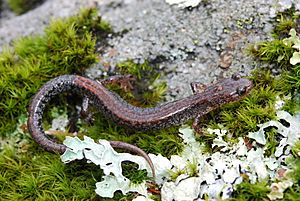Big Levels salamander facts for kids
Quick facts for kids Big Levels salamander |
|
|---|---|
 |
|
| In Augusta County, Virginia | |
| Conservation status | |
| Scientific classification | |
| Genus: |
Plethodon
|
| Species: |
sherando
|
The Big Levels salamander (Plethodon sherando) is a special type of salamander. It belongs to a family called Plethodontidae. This means it breathes through its skin and the lining of its mouth, not with lungs!
This salamander is found only in Virginia, in the eastern United States. When a plant or animal is found only in one specific area, it is called endemic. Scientists first described this salamander in 2004. Its scientific name, sherando, comes from Sherando Lake in the George Washington National Forest. Its common name comes from the Big Levels area in Augusta County, Virginia. This area has flat mountain tops in the Blue Ridge Mountains, which is where the salamander was discovered.
The Big Levels salamander is listed as a Vulnerable animal on the IUCN Red List. This means it could be at risk of disappearing because it lives in only a small area. We don't know much about what threatens it, but cutting down trees (logging) might harm its forest home.
What Does the Big Levels Salamander Look Like?
The Big Levels salamander is a small salamander. It is part of the Plethodon group, which includes the red-backed salamander. It looks a lot like the red-backed salamander (P. cinereus) and the southern red-backed salamander (P. serratus).
These other salamanders usually have gray and white (sometimes yellow) colors on their bellies. The Big Levels salamander has more white than gray on its underside. Its back can be red and gray, sometimes with stripes or spots. Compared to the red-backed salamander, the Big Levels salamander has longer legs. Its head is also a little wider.
The very first adult male Big Levels salamander found was about 95 millimeters (about 3.7 inches) long from its nose to the tip of its tail.
Where Does the Big Levels Salamander Live?
The Big Levels salamander lives in cool, moist places. Its homes include temperate forests and rocky areas. These are forests that have four distinct seasons.
Sometimes, it lives in the same areas as the red-backed salamander, especially at lower elevations. But at higher elevations, the Big Levels salamander is often the only small Plethodon species found.
A study in 2016 found that these two salamanders like different small areas within their habitat. The Big Levels salamander prefers spots with warmer air but cooler ground. The red-backed salamander likes places with more moisture in the air (higher relative humidity) and cooler air temperatures.


